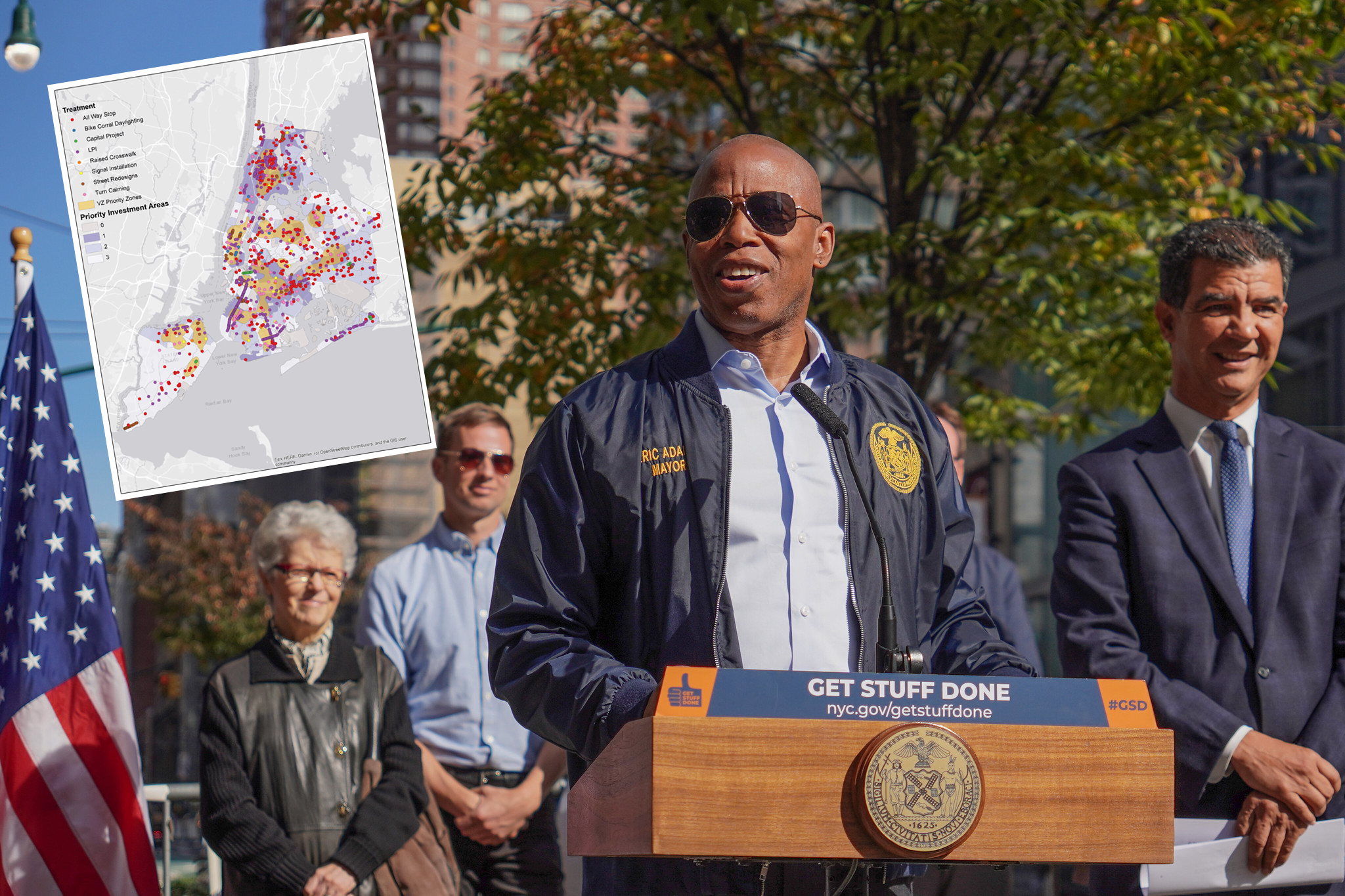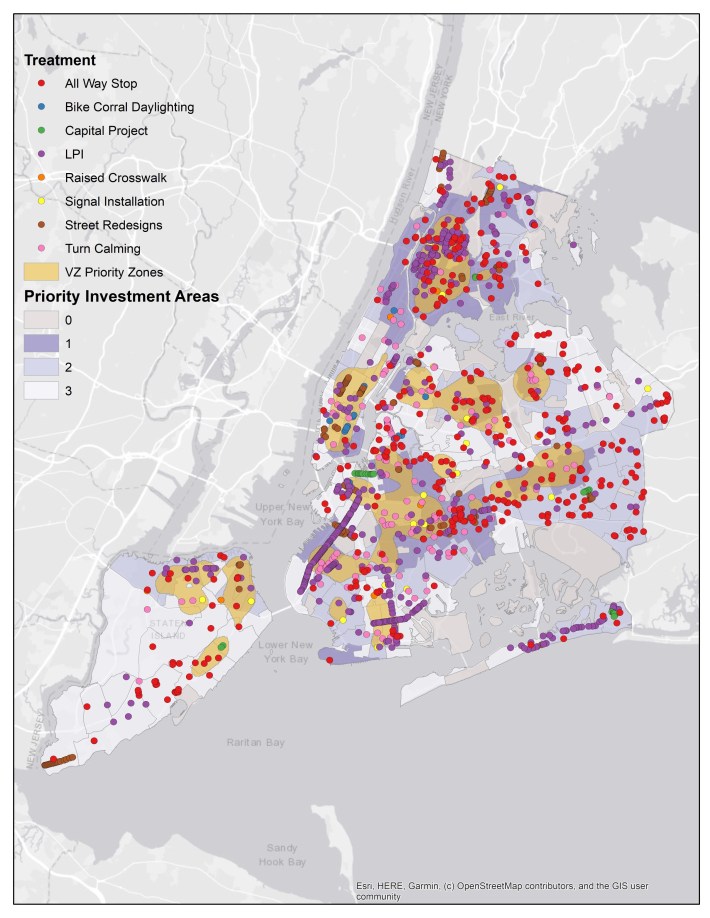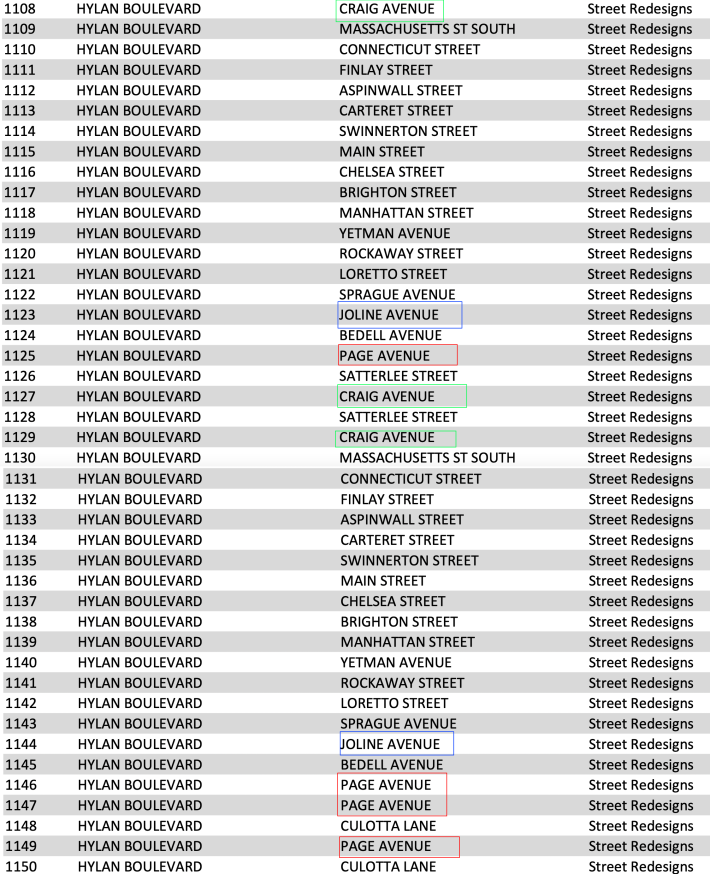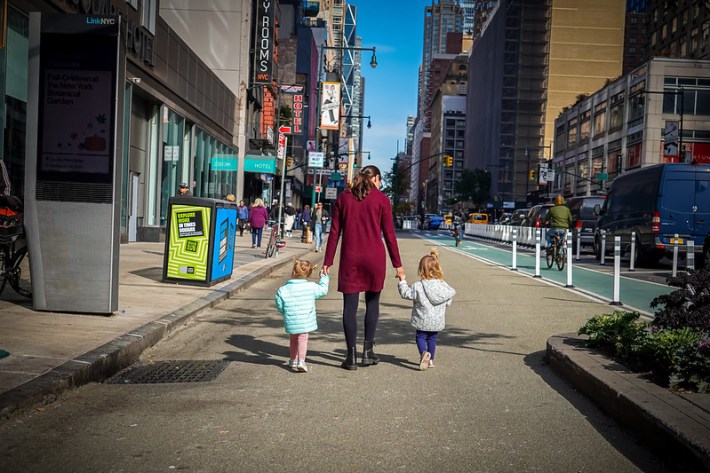Adams at the Crossroads: Mayor Touts Intersection Fixes As Road Violence Crisis Continues
12:01 AM EDT on October 31, 2022

Mayor Adams on Sunday released a list of more than 1,200 intersections that he says have received safety improvements. Photo: Benny Polatseck / Mayor’s Office
He's getting stuff done — but it's a little unclear what, exactly.

Mayor Adams announced on Sunday that his administration had exceeded his Jan. 19 promise to make safety improvements at 1,000 intersections by the end of the year, saying his agencies had actually completed more than 1,200 intersections — though only a small portion of the changes involved street redesigns.
The list put out by Adams on Sunday claimed that the administration has made 1,407 "intersection treatments," but scores of intersections were duplicates (see examples below), leaving 1,330 treatments. They break down this way:
- 524 leading pedestrian intervals (a light retiming that gives pedestrians a few seconds to cross before car drivers get a green)
- 359 all-way stop (these were intersections that only had a STOP sign in one direction previously)
- 202 unspecified street redesigns
- 147 turn calming
- 30 new signals
- 29 intersections daylighted
- 27 unspecified "capital projects"
- 12 raised crosswalks
- 1,330 total "treatments"
Adams presented his list at a press conference at Eighth Avenue and 46th Street, a spot along what is perhaps one of the most significant roadway redesigns of his administration: a narrowing of Eighth Avenue from four moving car lanes to two to accommodate far more pedestrian space and to make the protected bike lane remain free of walkers.
"Promise made, promise kept," Adams said of his intersection effort.
You be the judge: On Jan. 19, Adams and DOT Commissioner Ydanis Rodriguez promised to "make design improvements to make 1,000 intersections safer." The original press release said the effort would consist of:
- An unspecified number of "street design treatments ... focused on Vision Zero priority geographies, locations where fatalities and serious injuries have occurred, and Priority Investment Areas as detailed in the NYC Streets Plan." This includes new turn signals and LPIs, the press release said. (LPIs constituted 40 percent of the intersection treatment on Adams's Sunday list.)
- 100 raised crosswalks. Rodriguez said on Sunday that the city would complete 40 by the end of the year, well short of the 100 promise.
- 100 intersections “daylighted” with bike corrals. (Currently 71 short.)
- An unspecified number of "parking lot and gas station traffic-calming" measures so drivers can no longer "cut across sidewalks unpredictably." It is unclear if any of the changes announced on Sunday are in this category.
- 100 intersections featuring "physical elements ... to force turns at more appropriate speeds." (Promise kept, according to the data).
Adams also claimed on Sunday that the improvements were made at the "most-dangerous intersections," a claim that could not be verified. For instance, the DOT had previously identified 293 "Vision Zero priority intersections" based on having a disproportionately high number of pedestrian fatalities and severe injuries. But the vast majority of those intersections are not on the list released on Sunday. (Earlier in the year, when the city's open data website showed that the DOT had completed 713 intersections, only 18 of them had been Vision Zero priority intersections.)
Here's a chart of the DOT's changes (list here):
The preponderance of leading pedestrian intervals concerns some activists, who believe that far more is needed to rein in reckless drivers.
"Leading pedestrian intervals are good, but we know physical intersection safety upgrades are needed, too — which is why there are targets set for these, too," said Elizabeth Adams, senior director of Advocacy and Organizing for Transportation Alternatives. "We want to see as many physical infrastructure upgrades as possible and look forward to working with DOT on reaching their new year-end target for intersection upgrades, as well as meeting the requirements outlined in the NYC Streets Plan." The plan she referenced requires the city to install 30 miles of protected bike lanes and 20 miles of dedicated bus lanes this year, two targets on which the DOT is very far behind, according to TA and Riders Alliance.
DOT declined to provide a list of the actual improvements that were made at each intersection beyond the category (i.e. "signal intersection," "street redesign," etc), so it's unclear what work was done at any given intersection. DOT spokesman Vin Barone told Streetsblog that the label "street redesign" comprised "intersections improved as part of Street Improvement Projects" and are specifically projects that change the operation of the street, such as new bike lanes, new bus lanes and other safety treatments. But the DOT's "Street Improvement Project" website lists only nine intersections fixed this year, which is far fewer than the number on the list.
The agency admitted that its information can't be independently verified because not every change has been logged into the city's open data website, which is the only way for members of the public to follow up on what work is being done where. In addition, Barone said that some of the treatments have never before been logged in open data and the agency will soon figure out how best to do that.
And some of the information in DOT's list is impossible to verify. For instance, the city claims it added 30 new signals and 359 new all-way stop signs, but the city's online database of "Traffic Signal and All-Way Stop Study Requests" lists only 22 new traffic signal installations and zero all-way stop installations since Jan. 19.
Then again, the DOT's "turn calming" web page does indeed include 145 intersections calmed since Jan. 19 (roughly the same as the number Adams released on Sunday). The projects on that page, however, are identified only by longitude and latitude, while the items in the city's release on Sunday were identified by street name, making it impossible to cross reference the lists.
DOT will soon ensure that all open data is up to date, Barone added.

The city's manner of maintaining public data has already garnered the attention of Council Member Gale Brewer, who chairs the oversight committee and has promised Streetsblog that she will look into the issue.
"I love the idea," she said.
The data also annoy activists who have been eager to track Adams's promises.
"They claim they’ve done 'capital projects' and 'street designs.' but that’s vague, and we can’t judge if they actually include pedestrian safety improvements at specific intersections mentioned," said Liz Denys, a Transportation Alternatives volunteer who has been monitoring the open data website and sounded the alarm in September that the Adams administration appeared to be far behind on its pledge.
She also said it's frustrating to spend six months tracking DOT's promises and still be left in the dark.
"When I say this data is frustrating and unavailable, I do mean both at the level of 'it doesn't exist at all or isn't complete for stuff that does exist' as well as 'giant CSVs [spreadsheets] published to Open Data aren't very user friendly,'" she added. "Why didn't DOT just make a user-friendly tracker? Or at least release the list as they went? It's not just wonkier folks who want to see that our government is actually working on things like these safety changes."

One thing that is clear: Mayor Adams says he wants the government actually working on safety changes. At Sunday's presser, the mayor said many things that give succor to livable streets activists.
"More and more people are biking and more people are walking ... and we want to ensure their safety as we move forward," Hizzoner said. "But let's be clear here in New York City. We have and will continue to have a zero tolerance for traffic violence. These upgraded intersections are going to reduce the risk of traffic violence on our streets. These are real projects with real results. And we are not just stopping here. We're going to continue to have our North Star as being a zero tolerance for traffic crashes."
Zero tolerance would be exceptional. Between Jan. 1 and Oct 25, there have been 84,455 reported crashes*, or roughly 283 per day. Those crashes injured 40,062 people — or roughly 134 per day. Those injuries included 4,213 cyclists, 6,850 pedestrians and 28,999 motorists. More than 200 people have been killed this year.
To Rodriguez, that will mean a real culture shift in this city.
"We are not ready to celebrate," he said on Sunday. "We had a difficult year with overall traffic fatalities. This is what this administration inherited. But a bright spot has been that we have had among the fewest pedestrian fatalities this year in record history. ... We are doing everything we can to address reckless driving through commitments like this and other major efforts like the launch of 24/7 speed cameras this summer. ... We want to change the culture, we want to change the way on how they drive. So we are tackling traffic violence from all angles. Any loss of life on our streets is unacceptable and we are excited to build on this momentum going forward."
* The NYPD stopped routinely responding to non-injury crashes in early 2020.
Gersh Kuntzman is editor in chief of Streetsblog NYC and Streetsblog USA. He also writes the Cycle of Rage column, which is archived here.
Read More:
Stay in touch
Sign up for our free newsletter
More from Streetsblog New York City
Stockholm Leader’s Message to NYC: ‘Congestion Pricing Just Works’
"In Stockholm, people really thought that congestion pricing would be the end of the world, the city will come to a standstill, no one would be able to get to work anymore and all the theaters and shops would just go bankrupt. None of that happened."
Friday’s Headlines: Trump Trial Trumps Safety Edition
Is anyone going to bother to fix the dangerous mess on the streets and plazas around the Trump trial? Plus more news.
Adams Offers Bare Minimum to Seize Congestion Pricing’s ‘Space Dividend’ Opportunity
The mayor's list of projects supposedly meant to harness congestion pricing's expected reduction in traffic is mostly old news, according to critics.
OPINION: Congestion Pricing Will Help My Family Get Around As We Navigate Cancer Treatment
My partner was recently diagnosed with cancer. Congestion pricing will make getting her to treatment faster and easier.




